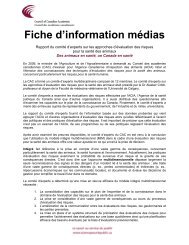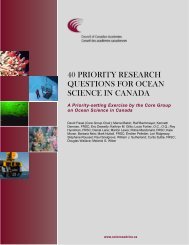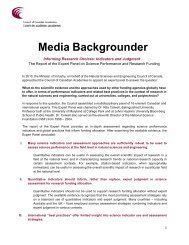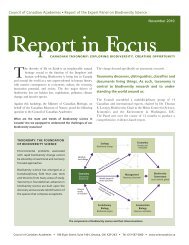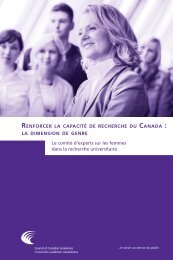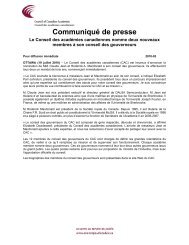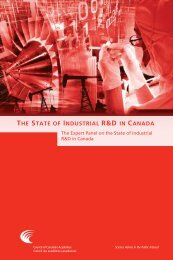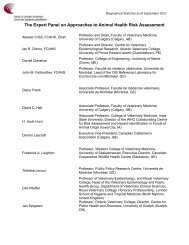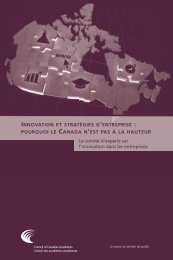an assessment of the evidence - Council of Canadian Academies
an assessment of the evidence - Council of Canadian Academies
an assessment of the evidence - Council of Canadian Academies
- No tags were found...
Create successful ePaper yourself
Turn your PDF publications into a flip-book with our unique Google optimized e-Paper software.
42 Influenza Tr<strong>an</strong>smission <strong>an</strong>d <strong>the</strong> Role <strong>of</strong> PPRE: An Assessment <strong>of</strong> <strong>the</strong> Evidencerelative import<strong>an</strong>ce <strong>an</strong>d <strong>the</strong> effectiveness <strong>of</strong> surgical masks used in this fashion asa control measure are unknown, as <strong>the</strong>y are typically employed simult<strong>an</strong>eouslyalong with o<strong>the</strong>r control measures such as vaccination, <strong>an</strong>tivirals, h<strong>an</strong>dwashing,<strong>an</strong>d contact precautions.Surgical masks may provide <strong>an</strong> incremental benefit in reducing tr<strong>an</strong>smission<strong>of</strong> influenza by minimizing or preventing body fluid splashes <strong>an</strong>d contact <strong>of</strong>contaminated h<strong>an</strong>ds to <strong>the</strong> mouth <strong>an</strong>d/or nose.The biggest limitation <strong>of</strong> surgical masks is that <strong>the</strong>y do not provide <strong>an</strong> effective sealto <strong>the</strong> face, <strong>the</strong>reby allowing inhalable particles access to <strong>the</strong> respiratory tract. Inaddition, <strong>the</strong> efficiency <strong>of</strong> <strong>the</strong> filter <strong>of</strong> surgical masks in preventing penetration <strong>of</strong>tracheobronchial or alveolar-sized particles has been found to vary from 2 to92 per cent under experimental conditions (Mitakakis, 2002; Brosseau, 1997;McCullough, 1997; Willeke, 1996; Tuomi, 1985; Cooper, 1983). The degree <strong>of</strong>protection against nasopharyngeal-sized particles is unknown. Some <strong>of</strong> <strong>the</strong>separticles may impact on <strong>the</strong> filter <strong>an</strong>d not penetrate, but o<strong>the</strong>rs c<strong>an</strong> be drawnthrough <strong>the</strong> gaps between <strong>the</strong> mask <strong>an</strong>d <strong>the</strong> wearer's face.SEASONAL VS. PANDEMIC INFLUENZAAlthough <strong>the</strong> protective capacities <strong>of</strong> PPRE <strong>an</strong>d o<strong>the</strong>r interventions apply to bothseasonal <strong>an</strong>d p<strong>an</strong>demic influenza, during a p<strong>an</strong>demic <strong>the</strong> absolute benefit <strong>of</strong> <strong>the</strong>seinterventions in preventing disease tr<strong>an</strong>smission may be greater th<strong>an</strong> in seasonalinfluenza because:• a high attack rate is <strong>an</strong>ticipated in a p<strong>an</strong>demic because <strong>the</strong> majority <strong>of</strong> <strong>the</strong>population will have no immunity;• this lack <strong>of</strong> immunity may also make people more susceptible to a smallerinoculum <strong>of</strong> virus;• viral shedding by infected persons may be increased <strong>the</strong>reby contributing totr<strong>an</strong>smission;• p<strong>an</strong>demic disease severity, while unpredictable, is likely to be worse th<strong>an</strong> mostseasonal outbreaks;• vaccine will not likely be immediately available; <strong>an</strong>d• <strong>the</strong> efficacy <strong>an</strong>d availability <strong>of</strong> <strong>an</strong>tivirals may be limited.





